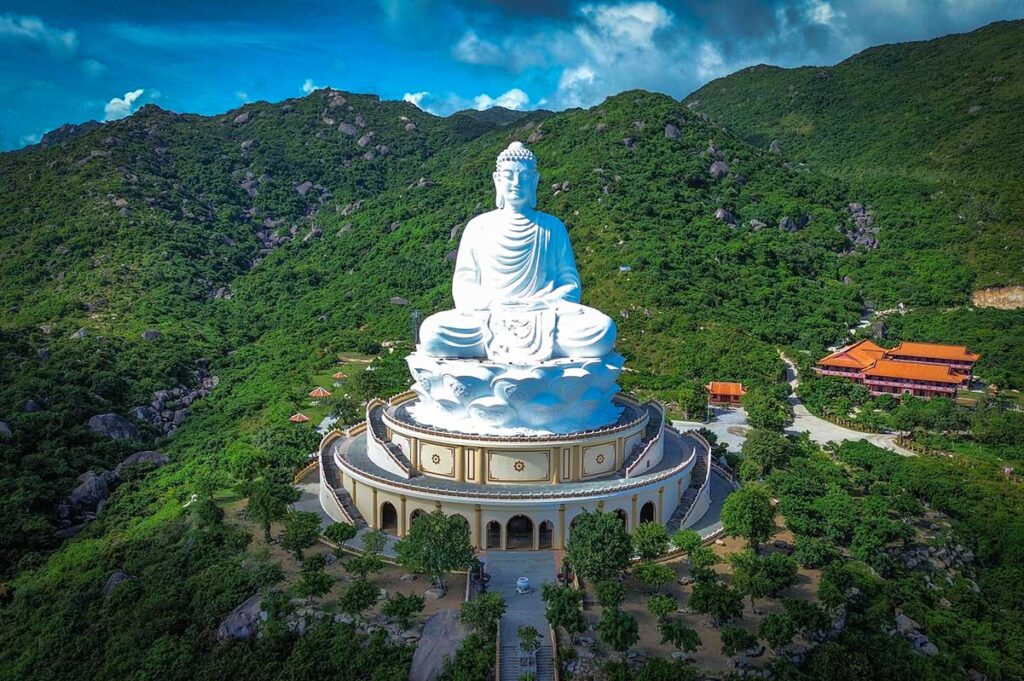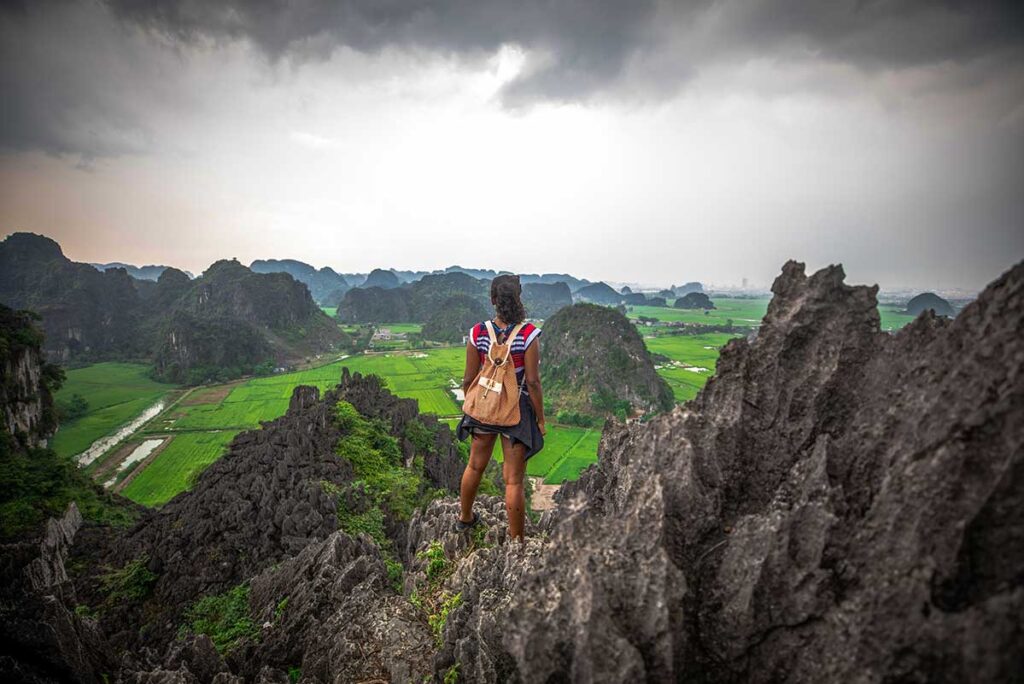What is Ong Nui Temple (Linh Phong Pagoda)?
Ong Nui Temple, also called Linh Phong Pagoda, sits on Chop Vung Mountain about 30 kilometers north of Quy Nhon.
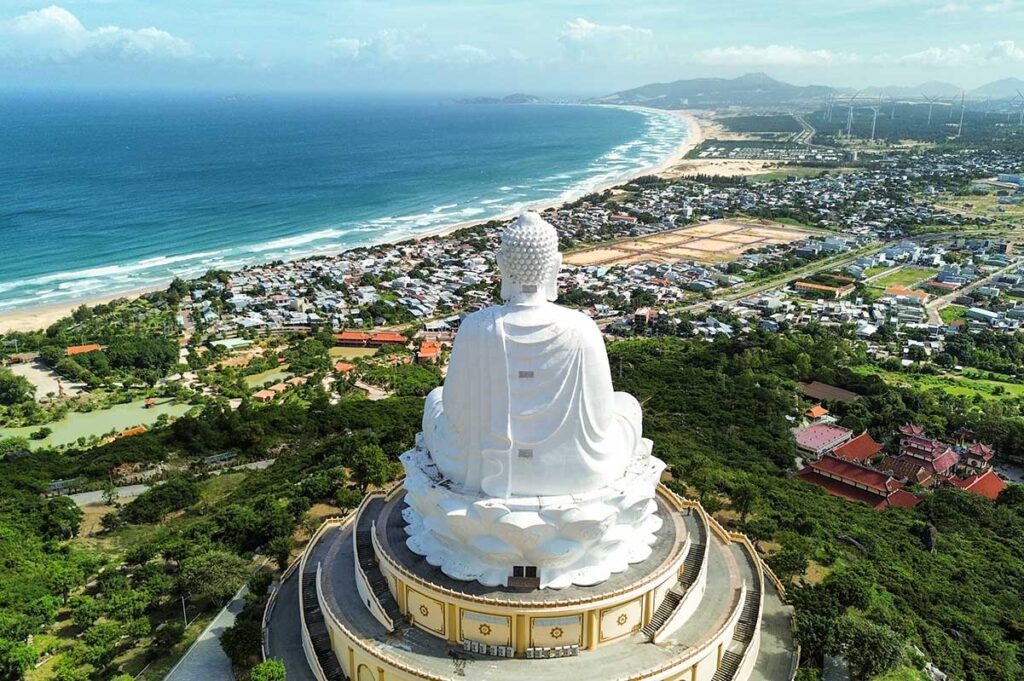
The temple is best known today for its enormous seated Buddha statue, visible from the coast below, and for the sweeping views of sea, rice fields, and fishing villages that you get from the hillside. Beyond the monument, it remains a functioning Buddhist site where monks live and study, though the scale of recent construction means it now attracts many day visitors.
Historical background
The origins of the temple go back to 1702, when a monk named Le Ban built a hermitage here. Locals called him “Ong Nui,” or “the old man of the mountain,” and his reputation for spiritual dedication drew support from Lord Nguyen Phuc Chu, who helped turn the hermitage into a larger temple complex. Over the centuries, wars damaged much of the original structure, and what you see today is mostly reconstructed. Despite that, the site has kept its role as a place of worship and pilgrimage for people in Binh Dinh Province.
Setting and religious significance
The temple sits on the slopes of Chop Vung Mountain, facing the South China Sea. The location itself is part of the attraction: fresh breezes, high vantage points, and a mix of coastal and countryside scenery make the climb worthwhile even if you’re not deeply religious. For local Buddhists, the temple remains a respected site for prayer and ceremonies, with the giant Buddha statue serving as a modern symbol of peace and devotion.
Highlights of visiting Ong Nui Temple
1. The climb up the stairs

Reaching the main temple and Buddha means tackling a long staircase — usually described as 600 to 759 steps depending on who’s counting. In the cooler hours it’s a steady workout; in midday heat it can feel punishing.

Along the way you pass smaller statues and rest spots where you can catch your breath. Making it to the top feels like part of the experience, and many visitors see the climb as an achievement in itself.
2. The giant seated Buddha statue

The star attraction is the massive seated Buddha, about 108 meters tall if you include the base, often described as the tallest of its kind in Southeast Asia. From a distance it dominates the mountainside, but up close the scale is even more striking.

Inside, the walls are covered floor to ceiling with rows of golden Buddha figures, which makes the interior just as impressive as the exterior. Some visitors also notice a vent or window detail at the back of the statue — a small but unusual architectural feature.
3. Views from the top
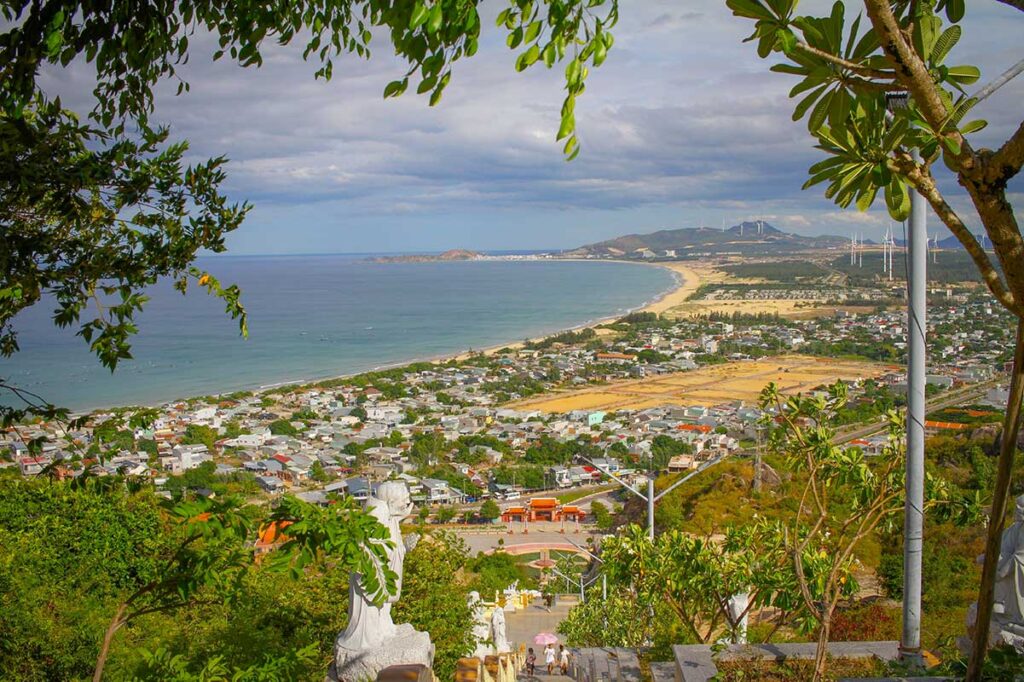
Once you reach the upper platforms, the reward is a wide panorama of Quy Nhon’s coast, Ky Co Beach, and the plains stretching inland with rice fields and villages. The sea breeze keeps it cooler than the climb, and it’s a place where you can pause for photos or just take in the view. Sunset and early morning light make the scenery even more memorable, though those times are also when you’ll need to plan around opening hours and transport.
4. To Cave and other temple features
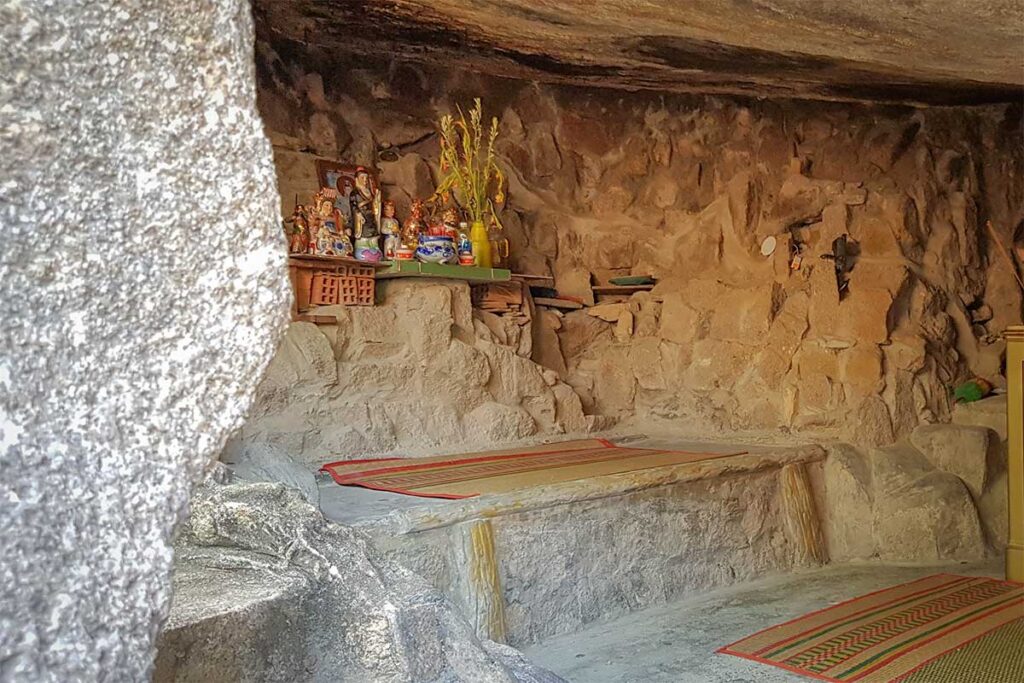
Part of the site’s history is linked to To Cave, where monk Le Ban is said to have lived and meditated in the early 18th century. The cave itself is small and still has an altar inside, though it feels secondary compared to the modern complex above.
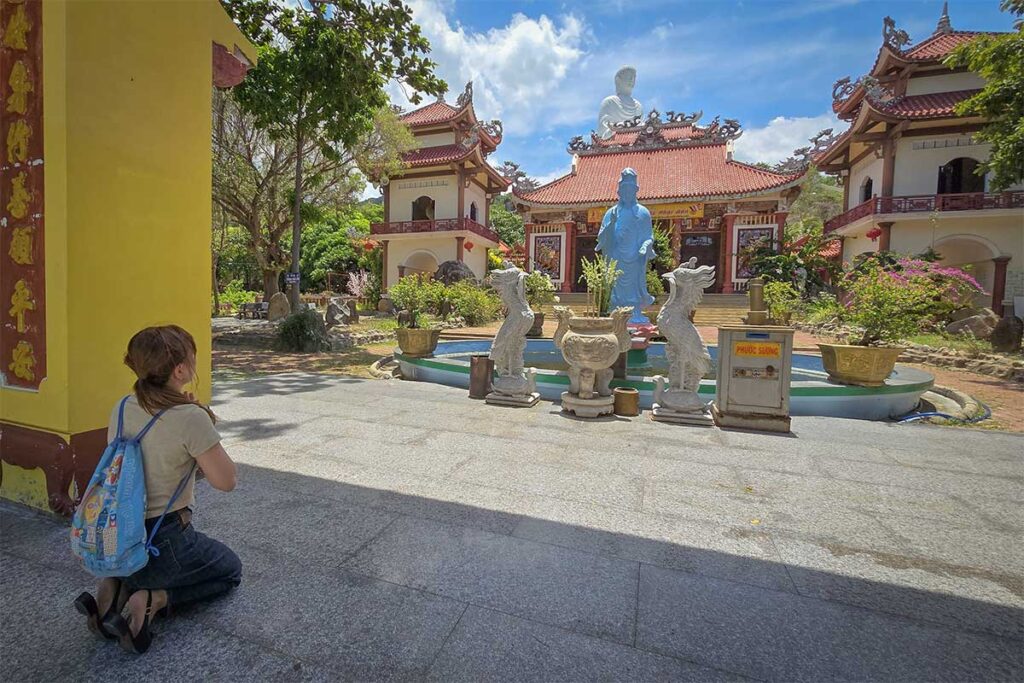
At the base of the mountain you’ll also find Linh Phong Co Tu, the older pagoda, which gives a glimpse of more traditional temple architecture. The complex is still active, with a community of monks who live and study here, reminding you that despite the monumental scale of the new structures, it’s not just a tourist site.
Ong Nui Temple Festival
Each year, Ong Nui Temple hosts a festival on the 24th and 25th days of the first lunar month. The event commemorates Venerable Thich Trung Tinh, an abbot who played an important role in the temple’s development.
For locals, this is both a spiritual gathering and a cultural celebration. Pilgrims come to offer incense at To Cave, join ceremonies, and pray for good fortune in the year ahead. The usually quiet temple grounds become crowded, with food stalls and a lively atmosphere replacing the solitude you might find on a normal visit.
If your trip coincides with the festival, expect a more vibrant but busier experience. If you prefer peaceful exploration, it’s better to plan your visit outside these dates.
How to get there
Where is Ong Nui Temple located?
Ong Nui Temple is about 30 kilometers north of Quy Nhon, set on Chop Vung Mountain along the Phuong Mai Peninsula. The site is easy to spot thanks to the giant white Buddha visible from the coast road. Travel time from Quy Nhon is roughly 40–50 minutes by car or motorbike.
Taxi or Grab
Taking a taxi or booking a Grab from Quy Nhon is straightforward, but arranging a ride back can be trickier since the area is quiet. If you go this route, it’s worth asking the driver to wait while you visit and agreeing on a return fare in advance.
Car with driver
Hiring a car with driver is a more reliable option and allows you to combine Ong Nui Temple with nearby stops like Ky Co Beach, Eo Gio, or the Phuong Mai Sand Dunes. This works well for a half-day or full-day trip without the stress of finding transport afterward.
Motorbike
For those comfortable on two wheels, renting a motorbike in Quy Nhon is popular. The coastal roads are generally quiet and scenic, passing lagoons, dunes, and fishing villages. Just remember that an international license with the correct motorbike category is required to drive legally in Vietnam.
Practical visiting information & Tips
Opening hours
The temple grounds are generally open during daylight hours. Early morning tends to be the quietest time, while late afternoon is also possible if you want cooler temperatures and softer light for photos.
Entrance fees
Entry to Ong Nui Temple is usually free, but you may need to pay small fees for parking or to use on-site transport. Motorbike parking is typically around 10,000–20,000 VND, and a motorbike ride up the hill costs about 20,000 VND one way. These prices can change, so bring small bills.
The climb
The staircase has over 600 steps and can feel long in the heat. Bring water, a hat, and an umbrella if the sun is strong. It’s a good idea to take breaks at the rest spots and enjoy the smaller statues and viewpoints on the way up.
Alternative to the climb
If the stairs sound daunting, there are options. You can take a motorbike taxi or small electric van up to the Buddha at the top. Many visitors ride up and then walk down, which saves energy but still lets you enjoy the scenery and statues along the descent.
Facilities
Facilities are limited. There are some shaded areas to rest but not many food or drink stalls once you start the climb. Carry snacks and enough water with you, especially if you’re planning to spend more time at the top. Toilets are basic and may not be available everywhere.
Best time of day
Morning is best for avoiding the heat and bus groups, while late afternoon offers cooler air and good light for views over the sea and rice fields. Midday is the toughest time to climb due to the sun and lack of shade on the steps.
Dress code & etiquette
As with any temple in Vietnam, dress modestly. Shoulders and knees should be covered, and avoid very revealing clothing. Keep noise to a minimum inside the temple halls and follow the lead of local worshippers if you want to offer incense.
Photography rules
Photography is generally fine outdoors, but certain indoor areas may have restrictions. Watch for signs or guidance from temple staff, and avoid using flash inside halls.
Sights to combine a visit
A trip to Ong Nui Temple often makes the most sense as part of a broader outing. Right around the temple you have the lower Linh Phong Co Tu pagoda and To Cave, but the real opportunity is combining the temple with other stops on the Phuong Mai Peninsula. If you’re coming from Quy Nhon, you’ll cross Thi Nai Bridge, which spans Thi Nai Lagoon and connects the city to the peninsula. From there, several well-known sights lie within short drives of each other, making it easy to build a full day trip.
Eo Gio – dramatic coastal cliffs
Eo Gio is one of the most scenic spots in the area, with rugged cliffs, winding boardwalks, and sweeping views over the sea. It’s a popular photo stop and usually part of any Quy Nhon coastal itinerary. The best time to visit is early morning or late afternoon when the sun softens the harsh light on the rocks.
Ky Co Beach – famous turquoise beach
Often paired with Eo Gio, Ky Co Beach is known for its turquoise water and sandy bay. Access can be by road or via short boat rides offered from Nhon Ly. While it can get crowded with local tours, the water is inviting and a good contrast to the temple visit.
Phuong Mai Sand Dunes – unique landscape
Not far from the temple you’ll find the Phuong Mai Sand Dunes. The rolling golden dunes feel out of place so close to the sea, and parts of the area are also used for wind turbines and solar farms. Some visitors enjoy short sand-sledding runs, though the main appeal is the scenery itself.
Nhon Hai Fishing Village – seafood and snorkeling
Nhon Hai is a working fishing community with a laid-back vibe. It’s a good stop for fresh seafood and a chance to see the round basket boats used along this coast. The village also serves as a base for snorkeling trips to nearby Hon Kho Island, so it’s easy to mix a cultural and water-based stop into the day.
Is Ong Nui Temple worth visiting?
Whether Ong Nui Temple is “worth it” really depends on what you enjoy when traveling. If you appreciate grand religious sites, monumental statues, and sweeping sea views, then it’s definitely a rewarding stop. The climb, the sheer scale of the Buddha, and the panorama from the top all make an impression.
If you’re less enthusiastic about recently built, large-scale temple complexes, it may not feel as special. Much of what you see is modern construction rather than historic architecture, and for some travelers that makes the site less appealing.
Overall, Ong Nui Temple works best as part of a combined day trip around the Phuong Mai Peninsula — together with Ky Co Beach, Eo Gio, or the sand dunes — rather than as a standalone highlight.
